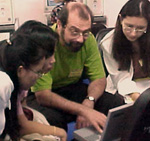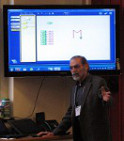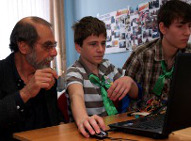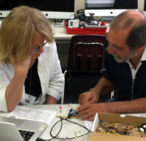Logo Foundation Staff
Michael Tempel
1963-1965 Columbia University School of Engineering and Applied
Science
1965-1967 Columbia College, B.A. Sociology, 1967
1967-1968 Columbia University Graduate Faculties, Sociology
1971-1974 City University of New York, M.S. Education, 1974
1979-1981 Teachers College, Columbia University, M.A. Computing in
Education, 1982
 |
 |
 |
 |
I was interested in science as a child, especially electricity and electronics. I used to scavenge old television sets on the street, disassemble them and use the parts in my own projects -- radios, Geiger counters and other devices.
I had intended to become an engineer, but as I went through college I became more interested in the social sciences. I graduated with a major in sociology and then went on to do graduate work in that field, specializing in survey research. But I found the academic environment overly specialized and somewhat disconnected from the real world. So I did something quite the opposite: elementary school teaching. The first requirement of teaching at that level is to have a broad general knowledge.
I was very fortunate to land in a school with a special program called the Open Classroom, which was inspired and led by City College Professor Lillian Weber, a leading advocate of constructivist, active learning. Unlike much teacher training, this program was intellectually challenging. I had read the works of Jean Piaget in college and graduate school, but it all seemed very abstract. Now his theories formed the basis of our educational practice.
During my 12 years of teaching I developed interdisciplinary classroom projects based on various themes including, ecology, aviation, music, and city planning. The Workshop Center for Open Education at City College provided a place for ongoing professional development where I attended and also taught numerous workshops and courses.
It was there that I was first exposed to the Summer Institute, an intensive, hands-on, project-based workshop for teachers that lasted one to three weeks. I have since applied and developed this methodology in numerous organizations where I have worked.
One of my classroom projects on the theme of city-planning included studies of structural engineering and architecture. This led me into a long collaboration with Mario Salvadori, a professor of civil engineering and architecture at Columbia University. Dr. Salvadori was one of the experts in the Scientists in Schools Program at the New York Academy of Sciences. We co-authored a teacher's guide on architectural structures that is still available today from the Salvadori Center an organization that Dr. Salvadori founded to further the work that we began at the New York Academy of Sciences.
The Scientists in Schools Program brought scientists and engineers into schools to work with students and teachers. The central idea of the program was that professional expertise should be part of the teaching and learning process in pre-college education. In 1980 I left the classroom to work full time on Scientists in Schools at the Academy of Sciences.
Another scientist in that program was MIT Professor Seymour Papert, who had been working for a dozen years on Logo, a computer-programming language designed for learning and accessible to young children as well as adults. I had worked with computers in the 1960s, when programming was done with punch cards or by rearranging wires on a circuit board. I liked tinkering with these machines, but I did not find an opportunity to incorporate them into a constructivist approach to learning and teaching. Dr. Papert's approach to computers and learning was very much molded by his long, close relationship with Jean Piaget. He had spent five years working at Piaget's institute in Geneva. Dr. Papert's vision was of the computer as a learning environment and tool that children could use for exploration and creation, a powerful idea that immediately resonated with me.
This was the time when personal computers were first making their way into schools. In 1981 I joined Logo Computer Systems (LCSI), a startup company devoted to developing Logo software. I worked on software and hardware development, writing, project management, marketing and education. At this time I also continued working with Dr. Papert and the Logo Group at MIT, which became the Epistemology and Learning Group and was incorporated into the Media Lab when it was formed in 1985. In 1991 Dr. Papert and I established the Logo Foundation, a nonprofit organization that provides support for Logo-using educators around the world.
In my years with the Logo Foundation, I have been involved in many projects focused on technology in education, building on my earlier experience with LCSI and the Epistemology and Learning Group at MIT. A prime example of this was the St. Paul Logo Project that was begun by Geraldine Kozberg in the St. Paul Minnesota public schools in 1980. For 18 years we engaged hundreds of teachers and thousands of students in Logo-based, constructionist learning.
Another very significant project that I was privileged to be involved in was the Programa Nacional de Informática Educativa in Costa Rica. In 1988, a group of 12 educators led by Clotilde Fonseca of the Omar Dengo Foundation came to the MIT Media Lab for an immersion into our constructionist approach to teaching and learning. I continued to work closely with the program over the years, including a year-long project in curriculum development funded by the Inter-American Development Bank from 1993-1994.
From 1996 to 1998 I was part of the startup team creating a new alternative middle school within the New York City public schools. I designed, built, and managed the school's computer network and taught computing, science, and mathematics.
There have been many other projects including Project Mindstorms in San Jose, California, The Iowa Early Childhood Papert Partnership in Des Moines, Iowa, Project Headlight in Boston, Project Lighthouse in Thailand, and the annual Logo Summer Institutes.
From 1998 to 2011 I worked at Schlumberger Excellence in Educational Development (SEED). I was able to utilize my expertise in engaging science experts in the education process by working with scientists and engineers to develop science content and hands-on activates that were shared internationally on a website along with an Ask the Experts feature that enabled students and teachers to interact with those scientists and engineers. At SEED I also had the opportunity to further advance theme- and project-based workshops for students and teachers in a dozen countries around the world.
More recently I have been working on developing educational programs in other organizations including the Luys Foundation in Armenia, iEARN, and Two Sigma. I continue to work with SEED, now focusing primarily on professional development for teachers in Houston, Texas area school districts. The Logo Foundation, now 34 years old, hosted the 46th annual Logo Summer Institute in July 2025.